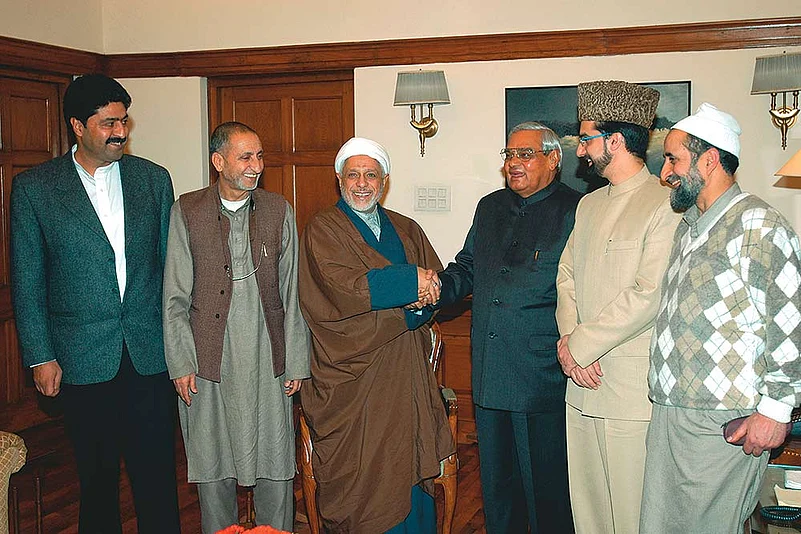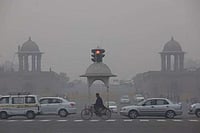Aug 1953 Sheikh Abdullah is arrested on charges of being a Pakistani agent and replaced by his deputy, Bakshi Ghulam Mohammad. Abdullah’s loyalists leave NC and form Plebiscite Front.
Feb 1954 The Constituent Assembly, under the leadership of Bakshi Ghulam Mohammad, passes a resolution ratifying the accession of Kashmir to India, while Sheikh Abdullah is in jail.
Dec 1963–Jan 1964 A mass uprising occurrs in the Kashmir Valley when the holy relic is found missing from the Hazratbal Shrine.
Nov 1964 The state assembly amends the Constitution, changing the posts of sadr-i-riyasat and prime minister to those of governor and chief minister.
1966 On January 10, the Tashkent Declaration is signed by India and Pakistan.
Jul 1972 Simla Agreement: India and Pakistan agree to respect the LOC and settle Kashmir’s fate bilaterally in the future.
1974 The Sheikh Abdullah-led opposition Plebiscite Front drops its demand for a referendum, and instead seeks greater autonomy for the state.
Feb 1975 The Indira-Sheikh accord is reached in February between Indira Gandhi and Sheikh Abdullah. Sheikh Abdullah dissolves the Plebiscite Front and assumes the position of chief minister of Jammu and Kashmir.
1987 Farooq Abdullah wins state elections, but it’s believed that the election was rigged. The MUF, which was said to be winning, is defeated. Insurgency begins in the Valley.
Jan 1990 Jagmohan is appointed governor of J&K. Farooq Abdullah resigns.
Jun 2000 The state assembly adopts a resolution accepting the report of the State Autonomy Committee, recommending greater autonomy. CM Farooq Abdullah expresses confidence that this will be implemented.
Apr 2001 PM Atal Bihari Vajpayee announces a political dialogue with all sections of J&K society, including those residing outside the state.
2001 K.C. Pant appointed as Centre’s first official interlocutor. Hurriyat Conference refuses to meet him. He meets some other leaders, but initiative stalls and comes to nothing.
Feb 2003 N.N Vohra replaces Pant as the new point man on Kashmir. Like Pant, he also struggles to negotiate with Hurriyat leaders who insist that they will only talk to the PM.
2004 After successful Indo-Pak dialogue on the sidelines of SAARC summit, Mirwaiz Umar Farooq and other leaders of his faction of Hurriyat hold talks with deputy PM L.K. Advani, and meet PM Vajpayee.
2005 After formation of UPA Government, Mirwaiz Umar Farooq along with Prof. Abdul Gani Bhat, Maulana Abbas Ansari, Bilal Gani Lone and Fazlul Haq Qureshi meet PM Manmohan Singh in September.
2006 Yasin Malik, accompanied by Ghulam Rasool Dar alias Eddi, meets Prime Minister Manmohan Singh on February 17.
2006 Mirwaiz Umar Farooq, accompanied by Prof. Bhat, Fazlul Haq Qureshi, Moulana Abbas Ansari and Bilal Gani Lone hold talks with Prime Minister Manmohan Singh in New Delhi on May 3.
2006-2007 Manmohan Singh sets up five working groups on J&K in March 2006 and starts round table dialogue. Separatists decline to participate, saying it degrades their position as only true Kashmiri representatives.
Apr 2007 Four working groups submit their reports to the PM but the fifth group on Centre-state relations headed by retired SC Justice Saghir Ahmed, waits until December 2009 to submit its report to CM Omar Abdullah.
Dec 2009 The fifth group reports that it is for the state’s people to decide on the future of Article 370. It also states that autonomy should be restored “to the extent possible”, and rejects the proposal for a Union Territory in Ladakh.
2010 Interlocutors appointed after unrest. They recommend reviewing all central laws extended to J&K . This has not been followed up.






















.png?w=200&auto=format%2Ccompress&fit=max)



